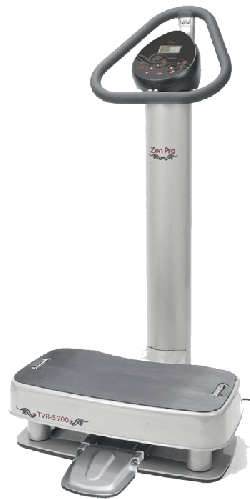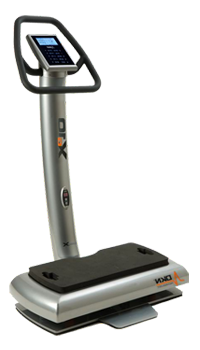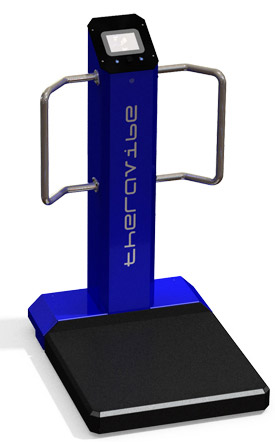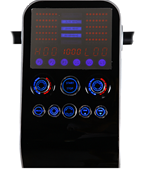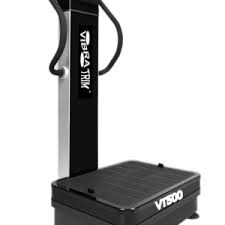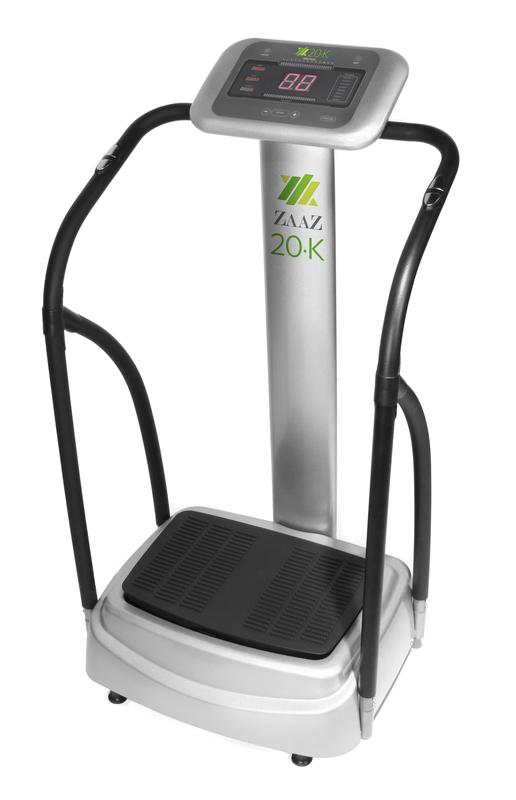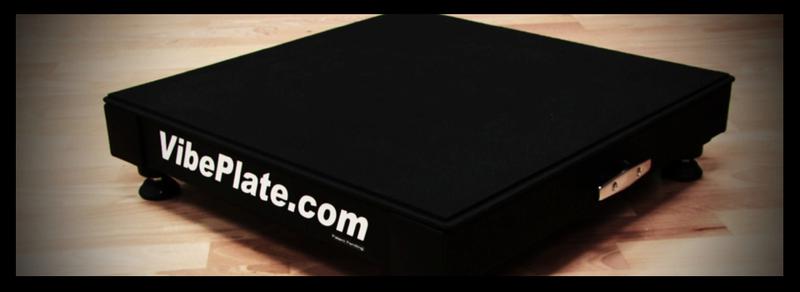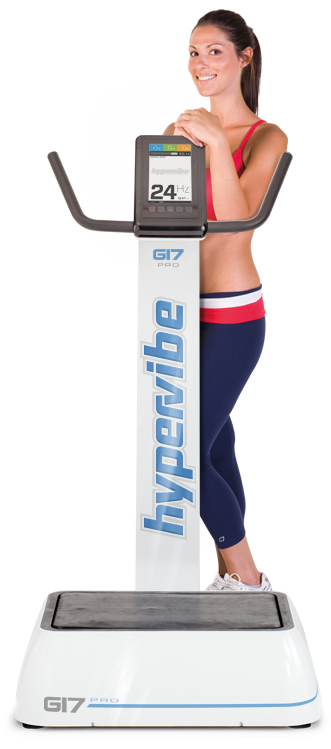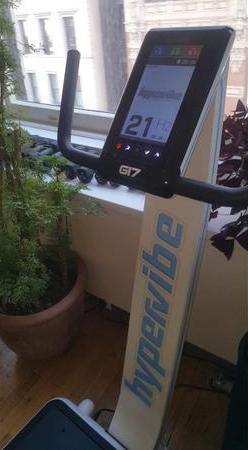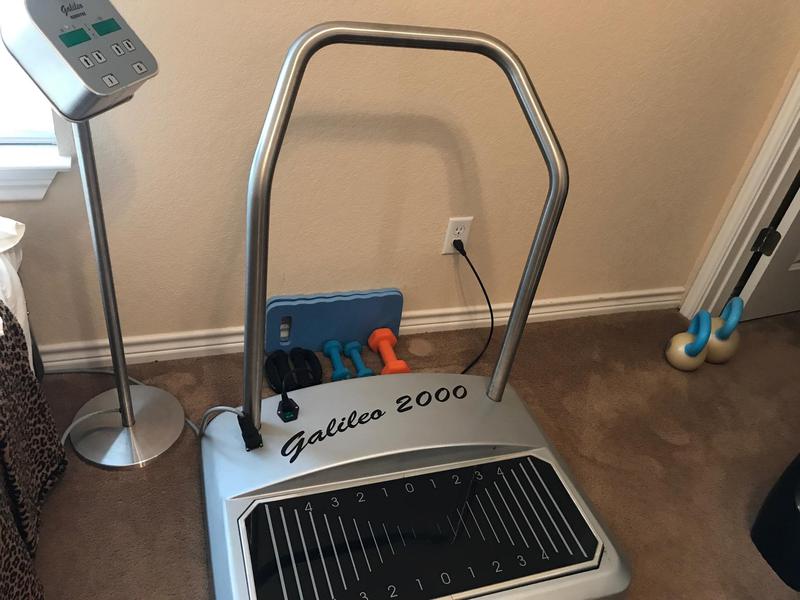“STOOD ON IT FOR 7 MINUTES" on high
I had a chance to review the Hypervibe G17 finally! I was instructed of course not bring in my phone so I couldn’t take pictures. It’s been about 6 hours since I tried it and all I can say is this thing is a beast.
I knew the power of their original machine so I’ll be honest I was a little intimidated. Stepping on it, the first thing I noticed was it was smooth. I immediately remembered how standing on the Galileo felt ($15,000 gold standard for pivotal WBV from Germany). What surprised me was that as I increased the speed I was expecting that smoothness to decline and the machine to maybe get loud or shake a bit but none of that happened. I cranked it up to where the original machine maxed out at 28 hertz. This thing purred like it wasn’t breaking a sweat…in fact I was the one breaking a sweat! Standing on the G17 at a speed of 20hZ felt as smooth as standing on most competitive brands around 6-10hZ.
The other thing I noticed is I felt more comfortable at that 28hZ speed compared to the original Hypervibe. With even more power behind each millimeter of displacement you feel the same consistent force behind the movement of the plate. It’s like the difference between a smooth Sine Wave or something with a short ascension and descent. Most brands I get on to test at higher speeds have almost a jagged wave and jackhammer type of pop to them.
When I did a new video review of the Galileo and Vibraflex (American brand name) I remembered how easy it was to stand on their plate even at the edges where the greatest magnitude is experienced. I’m not trying to make it sound like the G17 was simple to stand on and anyone can do it; I’m in really good shape and even still at a certain frequency point my body would just tense up too much from the acceleration force and I would slide off the plate. So this machine is really opening up a whole new range of conditioning potential.
The other thing I immediately noticed about the G17 was how little the plate’s frame and column with bars vibrated or shook. In fact it didn’t really shake, but I just felt a mild vibration. If we look at the Galileo design or the original Power Plate (now known as the Vibro Gym) These machines have a smart design because the handle bar column is not directly attached to the frame of the plate. Also the Vivo 660 was the other exception in that while it was attached to the frame the column didn’t move a bit. So the G17 whether it is at a slow hZ or high, the column is stable the whole way and that is quite unusual compared to other machines on the market. Even with the original Hypervibe, I would notice that at the slower speeds the handle bar column would shake more and then around 12hz+ it would stabilize out.
The other thing to note in regards to extraneous vibration of the frame around the plate is that the G17 also has the signature patented spring shocks legs that the Original Hypervibe has. They are the only company I have seen to have this design and it is absolutely necessary to have this instead of regular legs because with the speed and G Force power their machines are capable of producing, if it doesn’t have spring legs then the whole machine will vibrate across the floor and also could even damage an unprotected floor. Even though this is one of the most powerful plates the G17 doesn’t transmit much vibration to the ground even at 30Hz. It is far quieter than the original Hypervibe model. Besides the spring shocks the internal gears have eccentrics that function to counterbalance the platform momentum to kill the vibration to the floor. This is good to know if you live on a second floor or apt.
One easy test to tell a lot about the engineering of a machine (stability of the internal tilt mechanism and counter balances), simply tilt back the machine back with someone’s help so you can go around the front and look at the bottom of the plate. You can also turn on the machine in this position to note how much it shakes. If you see regular solid legs then you can assume that the machine does not produce significant G force (despite what they claim in the specifications). Usually solid legs will be sufficient for anything under 7Gs, very heavy machines at lower speeds, and or alternatively high end machines that are tuned so well they don’t vibrate into the frame much.
Going on the G17 was an eye opener to what real Gforce and real Frequency specs are supposed to feel like. If you haven’t seen my latest review videos I try to validate some of the specs on various machines using certain mechanical measuring equipment and I compare these results to an independent Engineering Firm’s tests performed with popular whole body vibration machines on the market. Even without using advanced testing equipment I challenge anyone to stand on the G17 or even the Original Hypervibe and put it at the same spec speeds you see other brands of machines are claiming. If a machine goes to 17 hz like the Vivo 460 for example, put the Hypervibe at 17hZ and test both. People will realize that even if other brands actually have legit frequency specs, that is just one aspect to pay attention to, the other more importantly is the Acceleration Force (G force) behind that frequency. The acceleration force is really what is responsible for all the health benefits and this also will depend on where you stand on the plate which effects the Magnitude.
This can also be proven even more scientifically with EMG (electromiography) electrodes placed on the muscles like the legs. These are Biomechanial analysis tools to be able to assess activation of those muscles based on the force it would receive from the plate.
So we know that the Galileo goes to 35hZ in regular mode and 40hZ in sports mode and that it can do this because it has been the best gold standard for a pivotal vibration machine. Some other companies claim this frequency range but 9 times out of 10 they are fraudulent. The Vivovibe 660 (which I have a picture above, costs $13,500 that goes to 40 hertz) is a good example of a machine that if you stood on it at 40hz you would hear and feel the difference between that and the Galileo. But this new G17 also making the 35hZ claim feels just like the Galileo.
On the Galileo and G17 performing a static hold squat at those high speeds I can survive for about 1 minute. Then I regret it the next day as I get out of bed. I can do 1 minutes on a Vivo 660 at “40 hz” and it’s easy, it makes me feel like some kind of Olympic champ in great shape. So if you are looking for a machine to appeal to your Ego then definitely purchase the Vivo 660 J Don’t get me wrong I’m not putting down that machine, but I just have a problem with a $13,500 price tag and 40hZ speed which isn’t really 40hZ.
Another key spec to pay attention to is that the G17 can hold 440lb. The Galileo can hold 160 kg 353 lbs max. That is almost 100lb more!! So if you weigh a lot and still want to bring on barbells you can do that. Also if you want to do squats with a heavy bar of weights that is possible as well. Ok but most people don’t fit into this specific type of usage, so the benefit of getting that extra 100 lb is that this shows that the G17 has a more robust design internally where it can generate that kind of force and power needed to move that kind of weight. Yes I’m actually saying that this machine might have trumped the Galileo with raw force power. Ok but what if you are just one person who needs something for your home for regular usage or for a small family…well this machine is probably over kill. Having all that extra power is great for if you have a large amount of people who will be using the machine like in a practice, gym, center, clinic, etc. That is why there are two other models of Hypervibe for most folks. The engineering accomplishment of the G17 model should make folks recognize that the company knows what it’s doing and make the other two models look that much more appealing.
I guess what really just blows me away about this machine over all is that after so many years of engineering Hypervibe somehow found a way to replicate or maybe surpass the Galileo (without lying about their specifications) but with at a fraction of the retail price tag. 1/5th the price to be exact.
Quick notes about health conditions:
For Bone Density the higher hZ and Gforce are definitely desirable.
For breaking through Cellulite, majorly backed up Lymphatic Systems this is a good machine
For those looking to train the muscles harder but with greater efficiency
When I stood on this machine my legs got itchy. I hadn’t experienced that on a machine so quickly because I am very well experienced and a regular WBV user. That effect usually takes me 15-20 minutes on with most machines. I got that effect this time within 5 minutes.
Because the amplitude goes to 7mm, this machine is probably one of the most least jarring even while standing on the widest edges of the plate. This is actually the ideal setup for a machine if it can do less amplitude but still bring the magnitude of acceleration force then one can be relatively comfortable even at high G force and speed. One could also say that if a person has challenges with their balance or might be very old, then lower amplitude is more desirable. I remember that with the 10mm amplitude on the original Hypervibe model, standing on the edges at higher speeds I would be more challenged to keep my feet from sliding (this is going barefoot)
- PowerVibe - VMaxFitness - DKN - Turbo Sonic - VIBEPLATE - TheraVibe - HyperGravity - VibraTrim - FitVibe - WAVE - HYPERVIBE - ZAAZ - VIVOVIBE
Hypervibe G17 Pro
This has to be the most powerful vibration machine I have ever been on. With the low 7mm amplitude at high speeds the ballistic impact is super low.
The Hypervibe G17 Pro: Latest update February
Everyone is saying it can't go to 35 hertz, it’s not possible. There are a couple other machines that make this claim people…All I remember it was more powerful than the Hypervibe Performance and very similar to the Galileo. The smoothness I have learned is some new stabilizing technology they came up with. They have probably done a similar design as the Galileo to get that effect..I talk about it in the above review. What I don't know yet is exactly how they smoothed things out besides the smaller plate size and reduced amplitude. It might be proprietary but I will do my best to get the inside information as I always do. The screen is color now and has some type of video playback..fancy shmancy. If I could just blue tooth in my baby monitor that would be perfect. Also, seems to have a built in trainer with hundreds of programs and exercises which is unusual. I didn't use that as I just stood on it the first time.
The older Hypervibe was still considered a residential machine although many physical therapy, Chiropractic clinics, and Gyms still purchased them. My old Hypervibe still works just as good as the day I bought it 5 years ago, never had to change a belt or anything.
The older Hypervibe weighed 110 pounds and this one is 60 more pounds. Based on what I was told about the older one, the machine had to be lighter when it goes at 28 hertz as it had to move in a wave so the machine wouldn't resonate.
I am sick of every company saying they have the best one that I had to build this site. I will not sell machines that I do not approve of. I will give honest advice and reasons for my recommendations based on my research.
Know before buying
Helpful Information
If you are interested in a Hypervibe G17 Pro Vibration machine call me at 1-866-945-9072. Ask for Jake.
coupon is good only on machines we stock. I will contact you with our lowest price today.
Discount Coupon Codes
We are not allowed to advertise under MAP prices (minimum advertised prices)
Get a coupon code for the machine for any machine we sell below.
Name:
Machine:
Model:
Contact Number:
Email:
Note: With any vibration machine I recommend never going to the edge of the plate and leaning 100% of your weight on your heals. Its a gradual thing. Many people don't listen and end up with bruised heals. This only applies to the high acceleration machines. For doing lymphatic exercise at the low hertz, this is never a problem.
The Hypervibe G17 Pro:
The Hypervibe is a much heavier machine than most and can be harder to set up. I have white glove delivery service at no additional charge only on this machine on my site. They will level it to your floor and put the machine together for you. I offer a 90 day guarantee with the G14 and G17 Pro models. I request people try the built in exercise programs for at least 30 days to see any differences. If you are not sure if the G14 or G17 is the right one for you, one of our experienced consultants (Sharon, Jake, or me) can help you pick out the right one based on your use and how your body might respond if you have any health issues. Each of the 3 Hypervibe models have different properties and different G forces on each speed. For those looking for lymphatic drainage, level 1 on a G14 has more displacement than level 1 on a G17 Pro. The G14 and G17 Pro are not for everyone but for those looking specifically for high acceleration training or have bad joints may find these two machines the only acceptable machines. Those looking for just lymphatic drainage and circulation do not need to spend the extra money and there are many other options. For bone density and weight loss, most machines will not cover that.
Hypervibe vs Galileo
The picture above is the original Vibration Machine from 1996. This was the one that went into space. I wanted to see if the original Galileo that costed over 40 grand in 1996 compares to any machines on the market today.
I have to say that the Hypervibe G17 Pro is way more powerful and advanced than the original. This is the original machine that started it all. I got it from a friend that had it from a closet in a hospital that hasn't been used since it was made and was sold on an auction. I bought this for 300 dollars. They did not know the value. I got really lucky to get one of these as I have been trying to find this original one that went into space since I started my site.
The Hypervibe G14 has just 5 speeds less than the original Galileo that went to 30 hertz. The G17 Pro goes 5 speeds higher than the original model. The original Galileo was so much louder than the Hypervibe G14 and G17. The tilt table on all Hypervibe models are based on a similar tilt table that I feel on the Galileo but much less choppy and much lower ballistic impact. The Hypervibe G17 Pro is the only machine that is comparable to the Galileo. For those not looking for super high acceleration the G14 is more suitable for most people.
Hypervibe G14 without the post and hand rails.
Without the rail has a different feel than with the rail. Some of the rebound effect can be lost in the rail also. The rail is great if leaning back on my heels where I want to do lymphatic drainage but on the high speed I prefer it without the rail
I am going to put my 2 cents in so here goes. I will state my opinion without polishing or editing. First, they compare a high acceleration machine to a high end residential machine. I have always compared the Hypervibe G14 to other brand that go to high acceleration speeds (Gravity Revolution, Nitrofit that goes to 22 hertz (the closest brand to the G14), and the Zaaz goes to 15 hertz, which most people use the machine at who are not trying to engage fast twitch muscles that will make them sore the next day. These machines were really made for bone density and circulation, not everyone is using a machine past 15 hertz. The Vibratrim VT500, Pulser 2 spiral machines go to 14 hertz and have been fine for nearly everyone that has ever bought one. No one that I recommended the machines that only go up to 14 herz ever returned it since they needed speeds over 20 hertz. Most people are doing this for lymph drainage, not so much exercise. Those that want to get an intense workout may want the higher speeds and not need the railing on the sides. The railing on the Zaaz 20K is helpful for those with balance problems and is actually needed. Most people don't do pushups on the Zaaz that I have interviewed after buying from me. The Zaaz doesn't need to be 170 lbs like the Hypervibe since it doesn't go to those speeds. The G force on the Zaaz has a lower rating but it is very high compared to 95% of the machines out there. At their highest level (15 hertz) it has 3.4 G forces. At 15 hertz on the G14 since it has 11 amplitude it has a higher G force feel. I always compare machines that are in the 14 to 15 hertz range to each other, including the Zaaz. Why would they compare the G14 that goes to 25 hertz to a 15 hertz machine. It is not a fair comparison. The Zaaz has many unique features that the G14 doesn't have. The Zaaz has the smoothest motor when comparing their machine to the VT500 or the Pulser. The VT500 has 5.8 G force but the plate is way heavier and it doesn't have that sinewave feel of the Zaaz. 3.4 G force delivered all at once feels nearly double the G force than 5.8 G force delivered in a "push) though the entire motion. The Zaaz is better than most of the machines in its price range but comparing it to a much more powerful machine is not fair. The Zaaz is the best made residential machine and I never hear complaints. I urge people to try the Zaaz at Costco or Sam's. With both brands I offer a money back guarantee without any restocking fees. I urge people to take my vibration quiz to see if you need these extra speeds. Also, the G14 comes without the rail and is much cheaper. I am doing a Hypervibe G14 vs Nitrofit Deluxe comparison which I believe is a much fairer comparison. 25 vs 22 hertz). The Nitrofit goes 3 speeds slower but has 13 mm amplitude instead of the 11amplitude of the G14. That is the closest comparison to the Hypervibe G14. If doing vibration mainly for lymph drainage, circulation and bone density the Zaaz is fine, but all the things they said was not cool about the ZAaz 20K to promote the G14 would only be optimal for someone who is going to do workouts. I believe the hand rails just like they are on the Zaaz is fine for those that need it (most of the people who buy the Zaaz probably need those rails). Sacrificing and not having the rails would only be optimal for those with working out as their primary focus. Contact me if you need help choosing between these brands.
ZAAZ 20K
VS
Hypervibe G14
I sell both of these machines and have a personal opinion on this widespread video going around.
First, these two machines should not be compared to each other as they are much different.
Site Update
We are no longer promoting Hypervibe G17, G14 and G10 models.
Call us for the new brand we promote.
LymphaticVibration.com
We're Open Now
1-888-439-8986
Ask for Sharon
1-888-439-8986
We're Open Now
Ask for Jake



